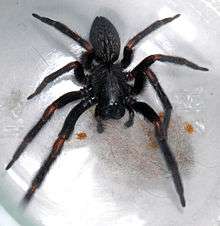Badumna
Badumna is a genus of intertidal spiders that was first described by Tamerlan Thorell in 1890.[5] They are harmless spiders that can be found around human structures and buildings. They are darkly colored, usually with a lighter colored pattern on the abdomen. The most well-known species is B. insignis, also known as the "black house spider" or "black window spider".[6]
| Badumna | |
|---|---|
 | |
| Badumna insignis | |
| Scientific classification | |
| Kingdom: | Animalia |
| Phylum: | Arthropoda |
| Subphylum: | Chelicerata |
| Class: | Arachnida |
| Order: | Araneae |
| Infraorder: | Araneomorphae |
| Family: | Desidae |
| Genus: | Badumna Thorell, 1890[1] |
| Type species | |
| B. hirsuta Thorell, 1890 | |
| Species | |
|
18, see text | |
| Synonyms[1] | |
Most of the species are from Australasia, but some have been introduced elsewhere. B. longinqua is the only species introduced to North America, now found in urban areas along California's Pacific coast.[7]
Species
As of May 2019 it contains eighteen species:[1]
- Badumna arguta (Simon, 1906) – Australia (Queensland)
- Badumna bimetallica (Hogg, 1896) – Central Australia
- Badumna blochmanni (Strand, 1907) – Australia (New South Wales)
- Badumna exilis Thorell, 1890 – Indonesia (Java)
- Badumna exsiccata (Strand, 1913) – Australia
- Badumna guttipes (Simon, 1906) – Australia (Victoria, Tasmania)
- Badumna hirsuta Thorell, 1890 (type) – Indonesia (Java)
- Badumna hygrophila (Simon, 1902) – Australia (Queensland)
- Badumna insignis (L. Koch, 1872) – Australia. Introduced to Japan, New Zealand
- Badumna javana (Strand, 1907) – Indonesia (Java)
- Badumna longinqua (L. Koch, 1867) – Eastern Australia. Introduced to USA (Coastal Florida and California),[7] Mexico, Uruguay, Japan, New Zealand
- Badumna maculata (Rainbow, 1916) – Australia (Queensland)
- Badumna microps (Simon, 1908) – Australia (Western Australia)
- Badumna pilosa (Hogg, 1900) – Australia (Victoria)
- Badumna scalaris (L. Koch, 1872) – Australia (Queensland, central Australia)
- Badumna senilella (Strand, 1907) – Australia
- Badumna socialis (Rainbow, 1905) – Australia (New South Wales)
- Badumna tangae Zhu, Zhang & Yang, 2006 – China
gollark: Eh, maybe? It depends on whether the "one way" they pick turns out to actually be good or not.
gollark: Especially with how old bits of the stdlib are.
gollark: I've found that in Python the one way to do it thing is a complete lie.
gollark: Not that it would be practical on the numbers you have probably.
gollark: Apparently O(n log n) time complexity was managed recently.
References
- "Gen. Badumna Thorell, 1890". World Spider Catalog Version 20.0. Natural History Museum Bern. 2019. doi:10.24436/2. Retrieved 2019-05-31.
- Lehtinen, P. T. (1967). "Classification of the cribellate spiders and some allied families, with notes on the evolution of the suborder Araneomorpha". Annales Zoologici Fennici. 4: 215–228.
- Marples, R. R. (1959). "The dictynid spiders of New Zealand". Transactions and Proceedings of the Royal Society of New Zealand. 87: 335.
- Gray, M. R. (1983). "The taxonomy of the semi-communal spiders commonly referred to the species Ixeuticus candidus (L. Koch) with notes on the genera Phryganoporus, Ixeuticus and Badumna (Araneae, Amaurobioidea)". Proceedings of the Linnean Society of New South Wales. 106: 249.
- Thorell, T. (1890). "Studi sui ragni Malesi e Papuani. IV, 1". Annali del Museo Civico di Storia Naturale di Genova. 28: 5–421.
- "Desis - Long-jawed intertidal spiders or lace web spiders". Spiders of Australia. 2006-12-20. Retrieved 2019-04-13.
- "Genus Badumna". BugGuide. Retrieved 2019-05-31.
This article is issued from Wikipedia. The text is licensed under Creative Commons - Attribution - Sharealike. Additional terms may apply for the media files.